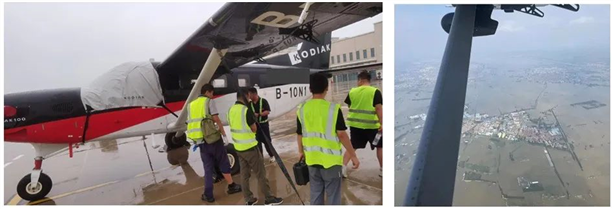IWHR gives its full support to China’s disaster relief amid Typhoon Doksori and Khanun, which hit the country hard and caused torrential rains and calamitous flood and inundation.
Experts from the institute’s Research Center on Flood and Drought Disaster Reduction, serving the Chinese government for flood control, went to flood affected areas, including Beijing, Hebei, Tianjin, Jilin, etc. immediately as the country issued its highest level of typhoon warning, providing technical advice for critical issues in local flood control.
The digital twinning system for prevention, forecast, early warning and drill of flood disasters, independently developed by IWHR, was applied to assist administrative government bodies in Beijing, Shandong, Anhui, Henan, Guangdong, Liaoning, etc. in the prediction and forecast of floods.
The institute’s space-air-ground integrated remote sensing and flood risk analysis technologies have been used to quickly establish flood analysis models for the eight flood detention areas that have already been put into operataion including thethe Haihe River Basin and the Lalin River and Mayi River in the Songhua River Basin in northeast China. Evolution of flood was analyzed every day on a rolling basis while reports of remote sensing and flood analyses were submitted continuously.

IWHR scientists use manned low-altitude remote sensing aircraft to collect data of flood-hit areas
The National Monitoring, Forecast and Early Warning Platform for Flash Flood Disasters, also developed by IWHR, has been applied to identify the 21,000 places with high flash flood risk in the Taihang Mountain region in central China. Experts announced to local governments the list of all high-risk places and provided practical plans for resident evacuation.
The entire team of the lab of IWHR’s Department of Water Ecology and Environment Research worked continuously for 30 hours for emergency monitoring of the water quality of the Yizhuang regulation pool, which is located in southern Beijing on the ring line of China’s South-to-North Water Diversion Project. Water supply for southern Beijing and neighboring areas was secured with the team’s solid technical support.
The Department of Irrigation and Drainage of IWHR provided prompt technical guidance for local water bureaus in flood-hit areas, boosting the security of rural water supply amid flood disasters.
Knowledge dissemination has also been carried out by IWHR. Videos about how to secure water quality and drinking water safety amid flood disasters were released by the institute and forwarded by China’s major media platforms, such as CGTN and Xinhua News. Several experts have guested on CGTN and the China National Radio to answer questions about flood disasters of public concern.